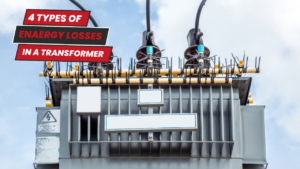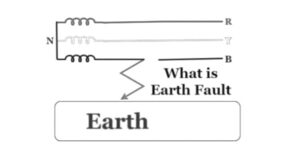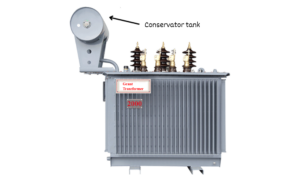Transformers are essential devices used in electrical power systems to transfer electrical energy between circuits at different voltage levels. They play an important role in the transmission and distribution of electricity. While transformers come in various types and configurations, two common designs are core-type and shell-type transformers. Understanding the differences between these two designs is crucial for engineers and anyone interested in electrical power systems.
In this blog post, we will discuss what makes core-type and shell-type transformers different from each other.

Core type vs Shell type transformer: Comparison Chart
| Aspect | Core-type transformer | Shell-type transformer |
| Definition | A type of transformer in which the magnetic circuit consists of two vertical sections called limbs and two horizontal sections called yokes and the windings placed on the limbs. | A type of transformer in which the magnetic circuit consists of one central limb and two outer limbs, and both primary and secondary windings are placed on the central limb. |
| Other names | Concentric winding or Cylindrical winding | Sandwich winding or Disc winding |
| Construction | The windings surround the core of the transformer. | The magnetic core surrounds the windings of the transformer. |
| Core Laminations Shape | The U and I shaped laminations are used for constructing the core of the core type transformer. | The core of the shell type transformer is made up of either U and T shaped laminations or E and I shaped laminations. |
| Cross-section of core | The cross-section may be square, cruciform or three-stepped. | The cross-section is rectangular. |
| Efficiency | Lower efficiency due to higher leakage flux | Higher efficiency due to lower leakage flux |
| Cooling Method | Natural oil or forced-air cooling | Oil-filled tanks for cooling |
| Core loss | More because the total magnetic flux flows through the entire core. | Less because half of the total flux flows in the entire core. |
| Require of Copper | More | Less |
| Size and Compactness | More compact | Larger in size |
| Limb | Two | Three |
| Insulation | More | Less |
| Mechanical Support | Core provides structural support for windings | Windings provide better mechanical support for stability |
| Applications | High voltage applications such as power transmission | High power and industrial applications |
| Maintenance | Easy | Difficult |
What is a Core type transformer?
Core-type transformers, also known as core-form transformers, are the more traditional design. In this configuration, the windings are wound around the core, which is made of high-permeability material such as laminated silicon steel. The core provides a low-resistance path for the magnetic flux generated by the primary winding, allowing efficient energy transfer. The windings are generally cylindrical or helical in shape, placed around the limbs of the core.
Key features of Core-type Transformer
The key features of the core-type transformer are as follows:
- Compact Design: Core-type transformers are known for their compact design, as the windings surround the core, resulting in a smaller overall size than shell-type transformers.
- High efficiency: The core-type design offers high magnetic coupling between windings, resulting in improved efficiency and lower losses.
- Lower leakage flux: The proximity of windings to the core in the core-type transformer reduces the leakage flux, minimising energy losses.
- Suitable for high voltage applications: Core-type transformers are commonly used in high-voltage applications, such as power generation and transmission systems.
Boost efficiency with our advanced core and shell type transformers, engineered for peak reliability and performance. Contact us for customised solutions.
What is a Shell-type transformer?
Shell-type transformers also referred to as shell-form transformers, have a different design compared to core-type transformers. In this configuration, the core is divided into two separate halves, and the windings are placed between the two halves. The primary and secondary windings are wound around a central limb, and the magnetic flux flows through the core and windings.
Key features of Shell-type transformer
The key features of the shell-type transformer are as follows:
- Robust construction: Shell-type transformers have a more robust construction due to external support provided by the frame and clamping structure, making them suitable for heavy-duty applications.
- Better cooling: The arrangement of windings in shell-type transformers allows for better cooling, as the windings are exposed to a larger surface area, facilitating heat dissipation.
- Suitable for low voltage applications: Shell-type transformers are commonly used in low-voltage applications, such as industrial and commercial installations, where compactness is not a primary concern.
- Higher leakage flux: Compared to core-type transformers, shell-type transformers have higher leakage flux due to the greater distance between the windings and the core.
Key differences between Core type and Shell type transformer
The following are the key differences between core and shell transformers.
Construction
Core-type transformers have windings surrounding the core limbs, whereas shell-type transformers have windings placed between two halves of the core.
Size and compactness
Core-type transformers are more compact compared to shell type transformers.
Cross-section Area
The cross-section of a core-type transformer is rectangular, whereas a shell-type transformer boasts shapes such as square, cruciform, two-slipped, or three-stepped.
Mechanical Strength
Core-type transformers exhibit lower mechanical strength, whereas shell-type transformers enhance strength through the incorporation of bracings.
Efficiency
Core-type transformers offer lower efficiency due to leakage flux whereas shell-type transformers generally exhibit higher efficiency due to lower leakage flux.
Cooling method
Core-type transformers often use oil or forced-air cooling, whereas shell-type transformers mainly use oil-filled tanks for cooling.
Applications
Core-type transformers are commonly used in high voltage applications, whereas shell type transformers are preferred for high power and industrial applications.
Maintenance
Core-type transformers involve the removal of fewer windings during maintenance, whereas shell-type transformers may require the removal of more windings.
Seeking a custom transformer solution? As your trusted transformer manufacturer in Australia, we’re here to build exactly what you need. Let’s create the perfect transformer together.
Core vs Shell-type transformers: Which is the better choice?
Choosing between core-type and shell-type transformers depends on specific needs. Core-type transformers are great for high-voltage situations because they’re cost-effective and easy to maintain. On the other hand, shell-type transformers work best in low-voltage situations because they’re good at handling electromagnetic forces.
Understanding these differences helps engineers make smart choices for their projects. As the power industry changes, knowing about these transformer types becomes really important for keeping electrical systems efficient and reliable.
Grant Transformer: Your trusted partner for reliable power solutions
Choosing the right transformer is crucial for smooth power distribution, whether it’s for long-distance transmission, local delivery, or industrial use. At Grant Transformer, we understand that and offer a wide range of high-quality transformers that fit your needs with precision.
Contact us today and find the perfect transformer solution for your requirements.



